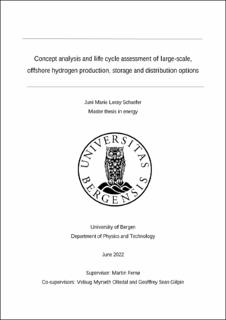| dc.description.abstract | The world and its inhabitants are facing pressing challenges related to the global warming of the Earth. The increasing share of renewable electricity is forecasted to decrease emissions of greenhouse gases, but electrification is not suitable for all sectors. For the maritime and the industrial sector in particular, hydrogen made from renewable electricity is an alternative energy carrier with low emissions. Offshore wind is a renewable energy source with expected significant growth in the next decade and wind farms far from shore provide intensives to investigate hydrogen production offshore. The advantage of such system is that low-carbon fuels can be produced without stressing the onshore electricity system. An offshore hydrogen production value chain includes the need for production, processing, storage and distribution to shore. This thesis identifies two large-scale hydrogen storage solutions for monthly production from a 500 MW offshore wind farm: compressed hydrogen in porous, underground formations and liquid organic hydrogen carriers stored on a floating vessel. A concept analysis outlines the data for the environmental analysis, which is performed by the standardized method of life cycle assessment (LCA), to compare the environmental impact of the studies storage solutions. Generally, the results shows that hydrogen processing and storage part of the hydrogen value chain in a large-scale, offshore system are non-marginal and must be included to determine the environmental viability. A preferred storage solution from an environmental perspective cannot be determined, as the results overlap between defined scenarios. Nevertheless, UHS is generally related with a slightly lower emission, both greenhouse gases and other emission flows, has less deviation between defined scenarios and appear to have less system complexity. This combination leads the UHS case to appear as favorable within the boundaries of this thesis, but the LOHC case remains as an interesting alternative for further investigations for longer term hydrogen storage. | |
